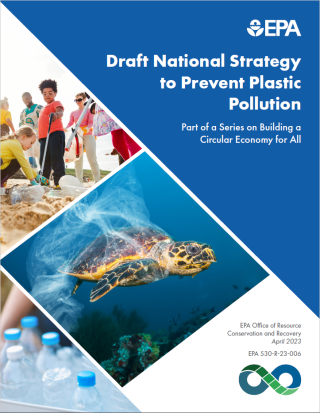Draft National Strategy to Prevent Plastic Pollution
On this page:
Summary of the Draft Strategy

The “Draft National Strategy to Prevent Plastic Pollution,” builds upon EPA’s National Recycling Strategy and focuses on actions to reduce, reuse, collect, and capture plastic waste.
New and innovative approaches are necessary to reduce and recover plastic materials and improve economic, social, and environmental impacts. With input from organizations, EPA identified three key objectives for the strategy:
- Objective A: Reduce pollution during plastic production.
- Objective B: Improve post-use materials management.
- Objective C: Prevent trash and micro/nanoplastics from entering waterways and remove escaped trash from the environment.
Shifting to a circular approach for plastics management in the U.S. involves actions surrounding:
- Understanding the effectiveness of programs and policies, and preventing plastic pollution through reducing, reusing, collecting, and capturing plastics from land-based sources.
- Improving the U.S. capacity to reuse and refill products.
- Increasing data availability and conducting life cycle assessments to understand the environmental, economic, social, and health impacts attributed to plastics.
- Addressing and improving consumer outreach and understanding of the proper management of plastic and other waste.
- Improving the wastewater/stormwater management and capture systems.
We invite you to read through the draft strategy (pdf)(8.4 MB).
Access the executive summary (pdf)(554 KB).
Feedback on the Draft Strategy
EPA requested public comment on the Draft Strategy. The public comment period closed on July 31, 2023. EPA is currently reviewing all comments received. Please visit the docket for this draft to view submitted comments or for information related to the docket.
During the public comment period, EPA asked the public to consider several key questions in the draft strategy when reviewing and commenting on it:
- Which actions are the most important and would have the greatest positive impact at the local, regional, national, and global levels? Consider:
- Which actions can best protect human health and environmental quality?
- Which actions are most important to address environmental justice and climate change?
- What are the key steps and milestones necessary to successfully implement the actions in the draft strategy?
- What are the most important roles and/or actions for federal agencies to lead?
- Is your organization willing to lead an action or collaborate with others to implement the actions?
- What factors would your organization consider when determining whether to lead an action?
- What are potential unintended consequences of the proposed actions that could impact communities considered overburdened or vulnerable, such as shifts in production or management methods?
- What key metrics and indicators should EPA use to measure progress in reducing plastic and other waste in waterways and oceans?
- What criteria should processes other than mechanical recycling meet to be considered “recycling activities” (e.g., “plastics-to-plastics outputs are ‘recycling’ if the output is a product that could again be recycled into another product or to extent that it can achieve viable feedstock for new plastic materials”)? How should health and environmental impacts be considered in these criteria?
- Are there other actions that should be included in the Strategy?
- Should EPA expand the scope of the strategy to include sea-based sources?
- Should specific types of plastic products be targeted for reduction or reuse in this strategy?
- Do you have any additional information or recommendations for EPA regarding these or other proposed actions in the draft strategy?
